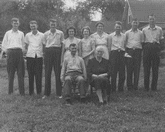|
Where was Transylvania
County
 Print This Page Print This Page
In 1813 South Carolina College mathematics and astronomy professor George
Blackburn complained about the difficulty of surveying a new and hoped for permanent boundary line
between North Carolina and South Carolina. Even the most modern survey equipment of the time proved
inadequate for the mountain terrain and difficult seasonal angles.[i] As a result, solving a
boundary line question that had existed since before the American Revolution involved local
techniques and political compromise. In the end, the surveyors and commissioners from both states
established a boundary not quite on the 35th parallel that North Carolina had claimed as its
Southern Boundary.
When Transylvania County, North Carolina was established in 1861, national politics held a higher
priority than boundary problems dating from colonial days. But for modern genealogists, knowing
what governments claimed present day Transylvania County is vital for locating important documents.
Since 1912, a simplified set of matching North Carolina maps has been used throughout the state by
amateur and professional historians and genealogists to show the changes in county administration
throughout the history of North Carolina.
While these maps are helpful, they can be misleading for researchers working with the western end
of the state. Of particular note is that the 1840 and 1850 maps show Haywood County as reaching the
South Carolina line - clearly separating Macon and Henderson Counties. However, a North Carolina
State Map prepared in 1843 clearly shows that at the time, Haywood County did not reach the South
Carolina line. Instead part of what is now Transylvania County, North Carolina was in the far
Southeastern corner of Macon County.[ii]
The error was simple enough to make. Transylvania County was formed from Henderson and Jackson
Counties. Jackson County was formed from Haywood and Macon Counties. And the Haywood County charter
established its boundaries as reaching the still to be determined South Carolina line. Since
Haywood County is closer to Transylvania County, the assumption was that the Haywood County part of
Jackson County moved into Transylvania County. These mistakes happen to the best of researchers.
When discovered, they offer a reminder about the danger of making assumptions and the importance of
never taking previous research for granted.
So we return to the original question of what earlier governments contain records from present day
Transylvania County, North Carolina. In 1763 the British proclamation line to establish peace with
the Cherokee and other native peoples clarified that all of Western North Carolina was outside of
British Territory. Prior to this time, North Carolina, South Carolina, and Virginia all competed
for the lucrative Cherokee deerskin trade - particularly South Carolina and Virginia. South
Carolina extended its jurisdiction over this trade throughout Cherokee Territory and some records
from what became Western North Carolina are located in the South Carolina Indian Trade
Journals.[iii] In particular, these records include correspondence from traders living in the area
in the 1750s.
For North Carolinians, the Blue Ridge Mountains created an important physical barrier to the
western lands and a serious hindrance in the Indian trade. Ultimately, North Carolina business
leaders looked to real estate instead of trade as a profitable venture for this area - an approach
that would be more successful if the Cherokee were gone. Near the beginning of the American
Revolution, North Carolina, South Carolina and Virginia sent troops to destroy all Cherokee
villages they could find. They were very successful burning homes and crops, killing many Indians,
and taking a few as slaves. Following this campaign, North Carolina established Burke and
Rutherford Counties and North Carolina records of present day Transylvania County began in earnest
as both counties issued many land grants to purchasers, whether or not they actually had the
authority do so.[iv] Rutherford County likely included some residents in present day Transylvania
County in its 1790 Federal Census.
The new Buncombe County, North Carolina began exercising some level of civil authority over present
day Transylvania County in 1792. While the majority of our future county remained in Cherokee
Territory, Buncombe County officials still issued grants, presided over the area in county court,
and included much of the area in its federal census records. The 1798 Treaty of Tellico and
subsequent Meigs-and Freeman Indian Boundary of 1802 clarified that the majority of the future
county was in United States control. For the area east of the Meigs and Freeman Indian Boundary,
Buncombe County relinquished control in 1838 with the formation of Henderson County.
For the area west of the Meigs and Freeman Indian Boundary, Haywood County adopted the vague civil
jurisdiction of the area previously maintained by Buncombe County in 1808. A treaty with the
Cherokee in 1819 moved full control to Haywood County, including the right of soil allowing legal
grants and settlement in the area. In 1828 the area covered by the 1819 treaty became the new Macon
County, North Carolina. Continued population growth led to the formation of Jackson County in 1851
and included this former corner of Macon County.
In 1861 the Meigs and Freeman Indian Boundary largely ceased to operate as a political boundary
with the creation of Transylvania County which again united the area. A somewhat altered shadow of
this earlier boundary line remains as the division between Hogback and Gloucester townships.
That is the North Carolina version of the story. In 1785, the Treaty of Hopewell opened up the
headwaters of both the East Fork of the French Broad River and Little River to settlement from a
South Carolina perspective. This state had also claimed jurisdiction over the southern end of the
fertile French Broad River Valley and in earlier negotiations with the Cherokee had established a
different boundary line allowing this settlement[v] As a result, that state issued land grants for
the area and may have included some residents in the 1790 and 1800 Federal Census records of
Pendleton District, South Carolina.
In 1802 Georgia, in a long term boundary dispute with South Carolina, managed to obtain South
Carolina’s claim from the Federal Government. Here, Georgia established the short lived original
Walton County, Georgia. North Carolinians with business interests in the region strongly opposed
the creation of Walton County and the resulting Walton War Boundary Dispute involved sporadic
violence and a great deal of heated rhetoric among all three states. The dispute between North
Carolina and Georgia essentially ended in 1811 and the dispute between North Carolina and South
Carolina ended in 1815 as a series of surveys and compromises, including the one involving George
Blackburn, clarified North Carolina jurisdiction once all Cherokee claims were
extinguished.[vi]
So what does all this mean for Transylvania County researchers? A lot of leg work. All of us will
need to work together to consolidate information about these distant research sources. It may not
be quite the same adventure as the people who lived through the changes and confusion faced. But it
does create unique challenges for those of us willing to venture into courthouses and archives in
search of our elusive past.
- Linda Hoxit Raxter, originally posted January 5, 2003
[i] George Blackburn, The Astronomer's Journal, ed. Minerva Wilson Andrews (McLean, Virginia:
Carolina-Virginia Genealogy Publishing Company, 1995), p 10.
[ii] Thanks to genealogist Marty Grant who first revealed to me the Macon County connection. This
has helped me tremendously since previously I had been looking in the wrong county for records
concerning my community. Macon County contains a wealth of land records for this area.
[iii] Of particular interest to this region is William L. McDowell, Jr., ed., Documents Relating to
Indian Affairs: May 21, 1750 - August 7, 1754, Colonial Records of South Carolina (Columbia: South
Carolina Archives Department, 1958). Information about the 1863 Proclamation line and the
surrounding racial relations can be found in Tom Hatley, The Dividing Paths: Cherokees and South
Carolinians through the Revolutionary Era (New York: Oxford University Press, 1995).
[iv] For a discussion of the legality of these grants in light of contemporary Cherokee Treaties as
well as the later evolution of Western North Carolina counties see George H. Smathers, The History
of Land Titles in Western North Carolina (The Miller Printing Company: Asheville, NC, 1938).
[v] More information about the Cherokee Treaties and resulting boundary confusion can be found in
Charles C. Royce, The Cherokee Nation of Indians, Introduction by Richard Mack Bettis (Chicago:
Aldine Publishing Company, 1975).
[vi] Further details about the Walton War Boundary Dispute can be found in Linda Hoxit Raxter, "The
Orphan Strip Community: Crucible of Cultural Change," (Master of Arts thesis, Western Carolina
University, 2002).
^ Back to Top
|






